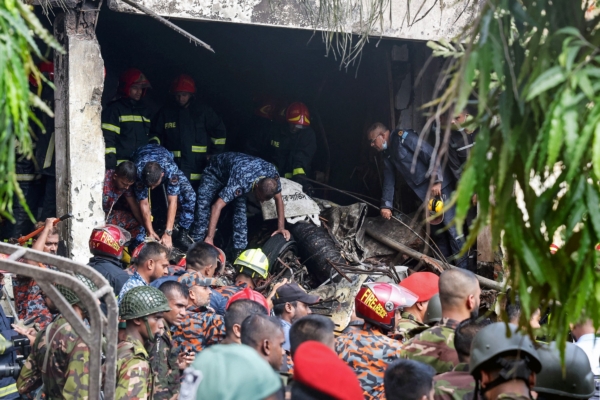Recently, there was a Chinese-made fighter jet crash in Bangladesh, a South Asian country, resulting in the death of 31 people. However, the Chinese Communist Party (CCP) officials remain silent on the crash involving the F-7BGI, a Chinese-made aircraft. In the past decade, there have been at least 9 incidents of Chinese-made fighter jets crashing, with 7 occurring within the last 5 years. Local experts in Bangladesh have pointed out safety hazards in the F-7 fighter jets, especially concerning the poor ejection seat performance leading to pilot fatalities.
On July 22nd, a Chinese-manufactured F-7BGI fighter jet crashed due to mechanical failure at a school in Bangladesh, resulting in at least 31 deaths, including the pilot.
Regarding this incident, China’s official Xinhua News Agency has refrained from mentioning that the crashed jet was the Chinese-made F-7BGI, only briefly reporting that “Bangladesh health officials said on the 22nd that the Bangladesh Air Force trainer aircraft crash has resulted in 27 deaths.”
The South Korean newspaper “Chosun Ilbo” recently found that there have been three previous crashes involving F-7 jets in Bangladesh in 2008, June 2015, and November 2018, with this being the fourth. In May of this year, there was a crash in Zimbabwe involving an F-7 resulting in the death of the pilot. In June, there was a crash of an FTC-2000G trainer aircraft in Myanmar. In May 2022, Iran also experienced an F-7 crash, leading to the death of two pilots. In June 2022, a J-7 fighter jet crashed in Xiangyang in northern province. Furthermore, Pakistan Air Force had two F-7 crashes in May 2020 and 2022.
According to Jane’s Information Group, the F-7BGI trainer aircraft is the final and most advanced model in China’s Chengdu J-7/F-7 series. Bangladesh signed a contract in 2011 to purchase 16 aircraft and completed delivery in 2013.
Public data shows that initially, the F-7 jet used the Soviet Union’s R-11 engine which was later replaced with the locally produced WP-7 turbojet engine.
According to the local newspaper “Dhaka Tribune” in Bangladesh, experts have highlighted that besides the outdated design of the F-7 jet, there are safety concerns in its structure. The Chinese-developed WP-7 turbojet engine faces reliability issues. In emergency situations, the performance of the ejection seat is poor, often resulting in pilot fatalities. Additionally, to achieve top speeds of up to 2.0 Mach in a small aircraft body, the width of the jet’s wings had to be reduced, compromising safety in terms of control.
The defense and security research head of the American Rand Corporation, Jacob Parakilas, stated in an interview with “Newsweek,” “The F-7BGI is a relatively new version of a quite outdated fighter jet, still plagued by design flaws of old Soviet fighter jets. Due to its focus on high-speed mobility, compared to fighter jets with larger wing spans, its adaptability during take-off and landing is poor, posing safety hazards.”
(Line breaks for readability)

